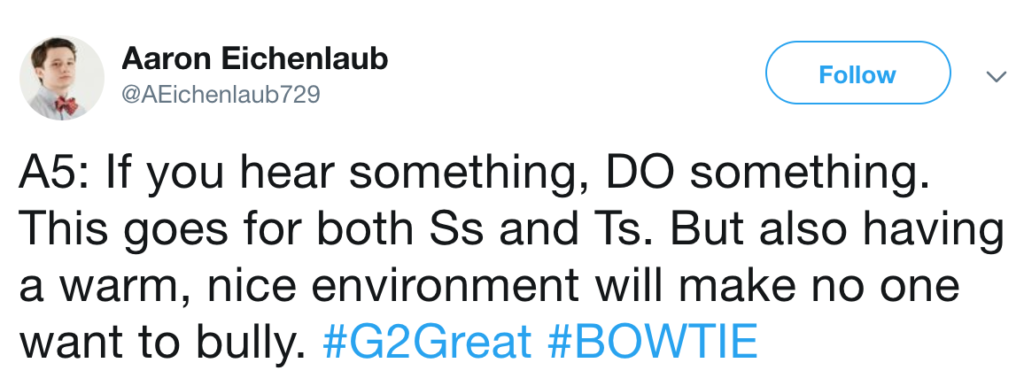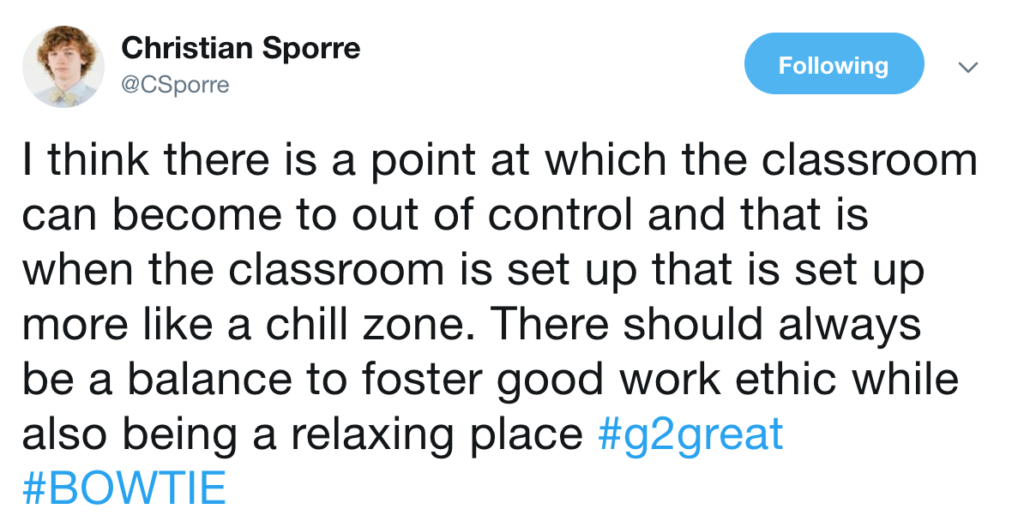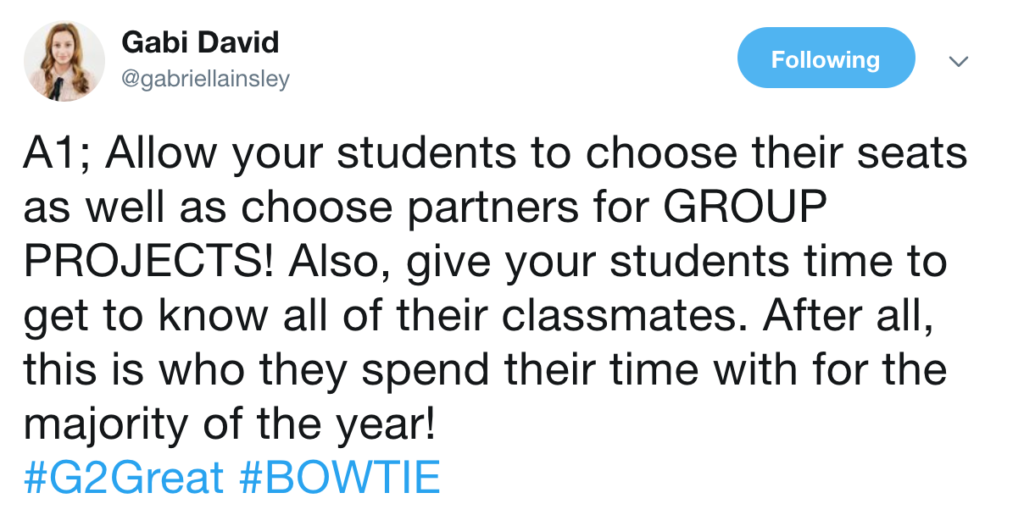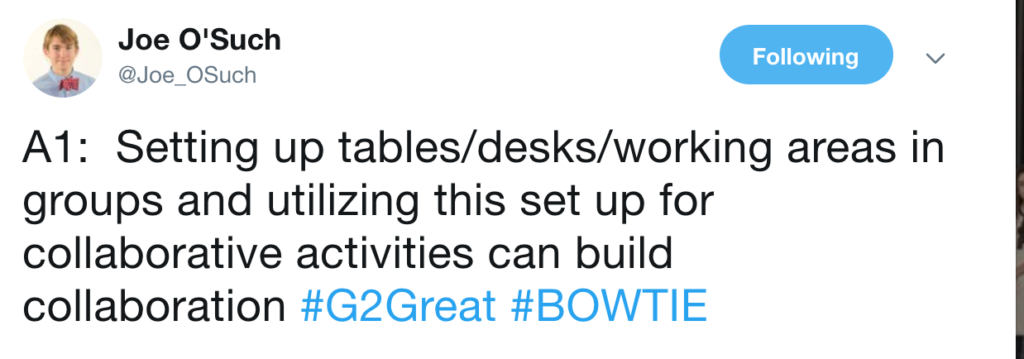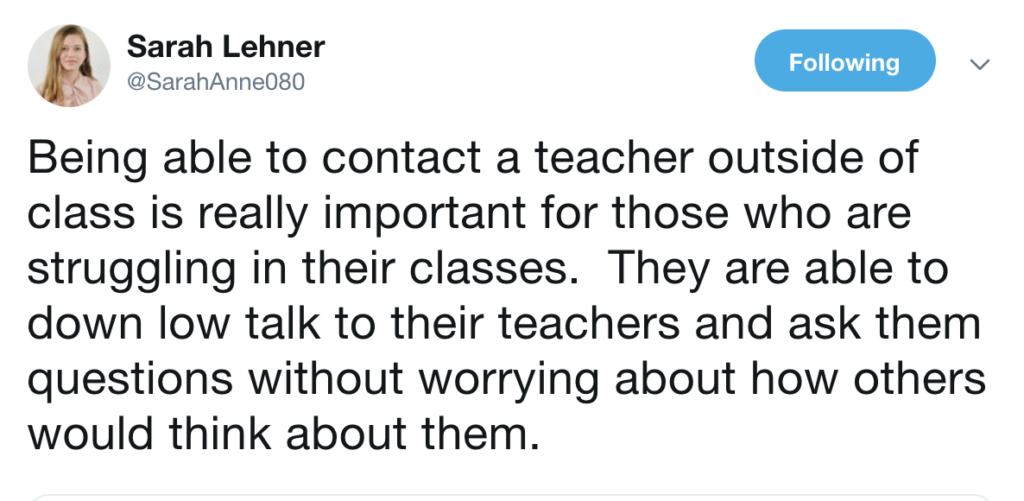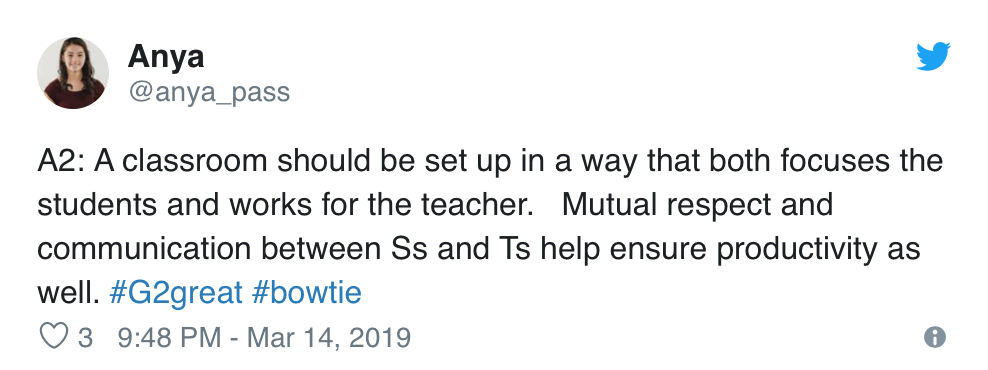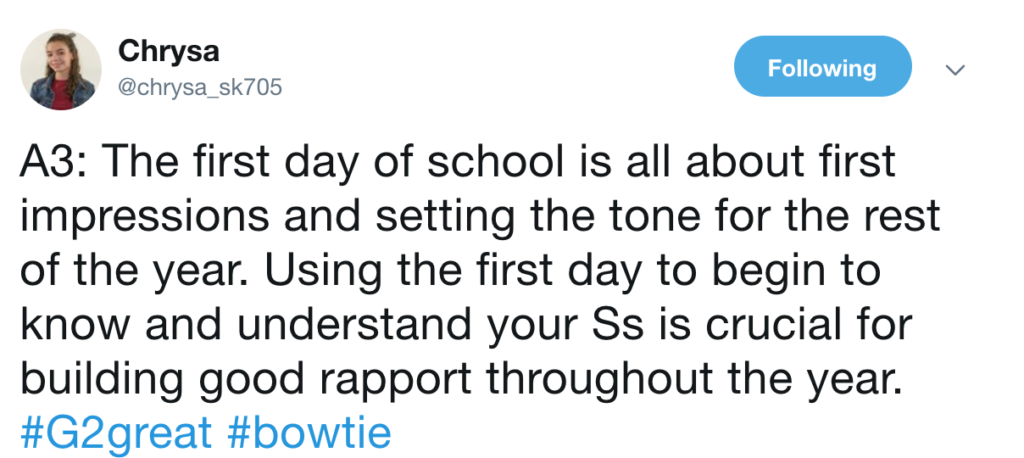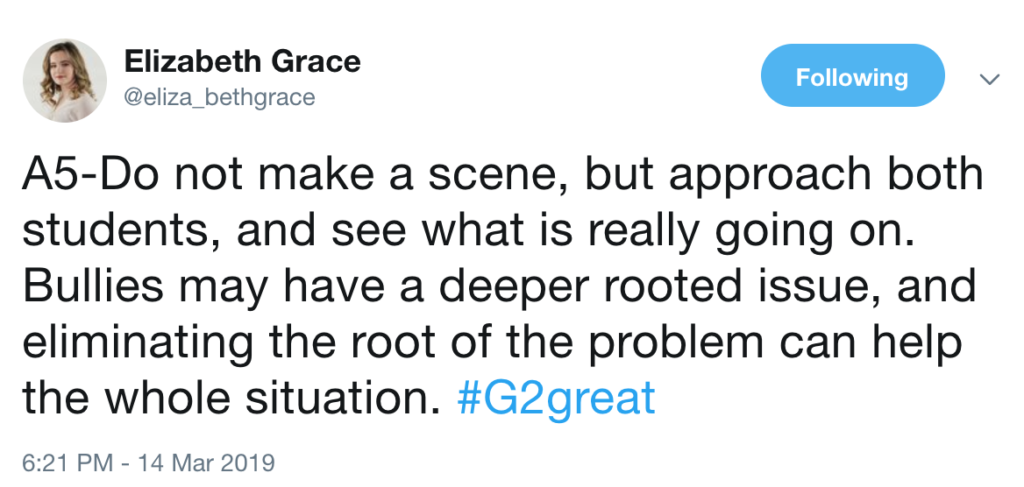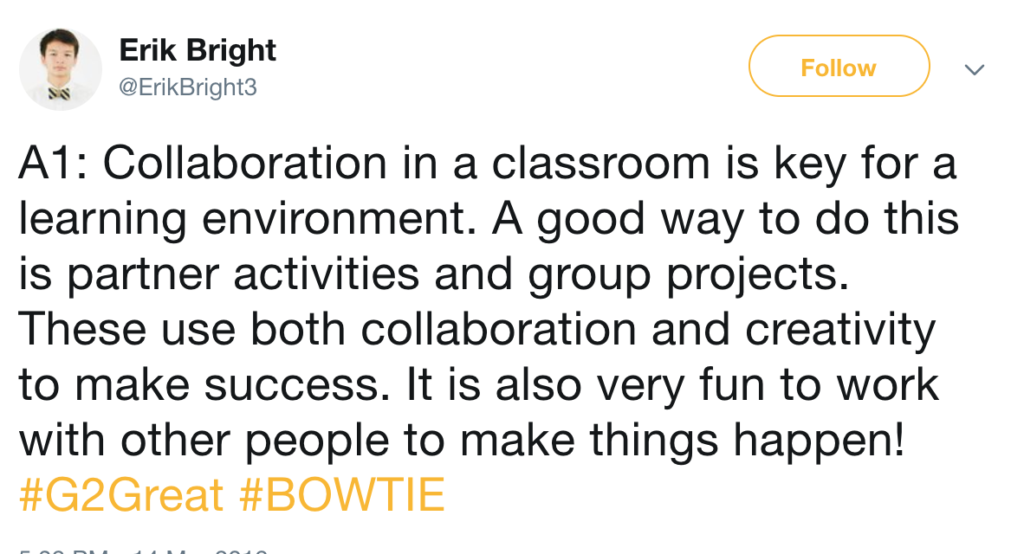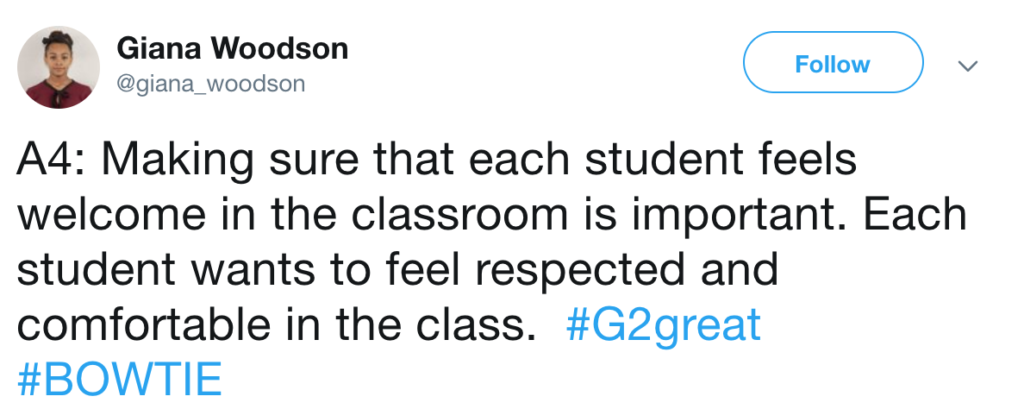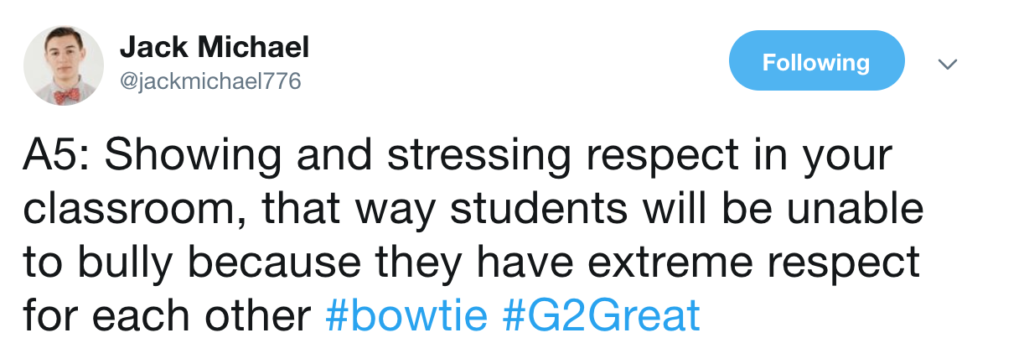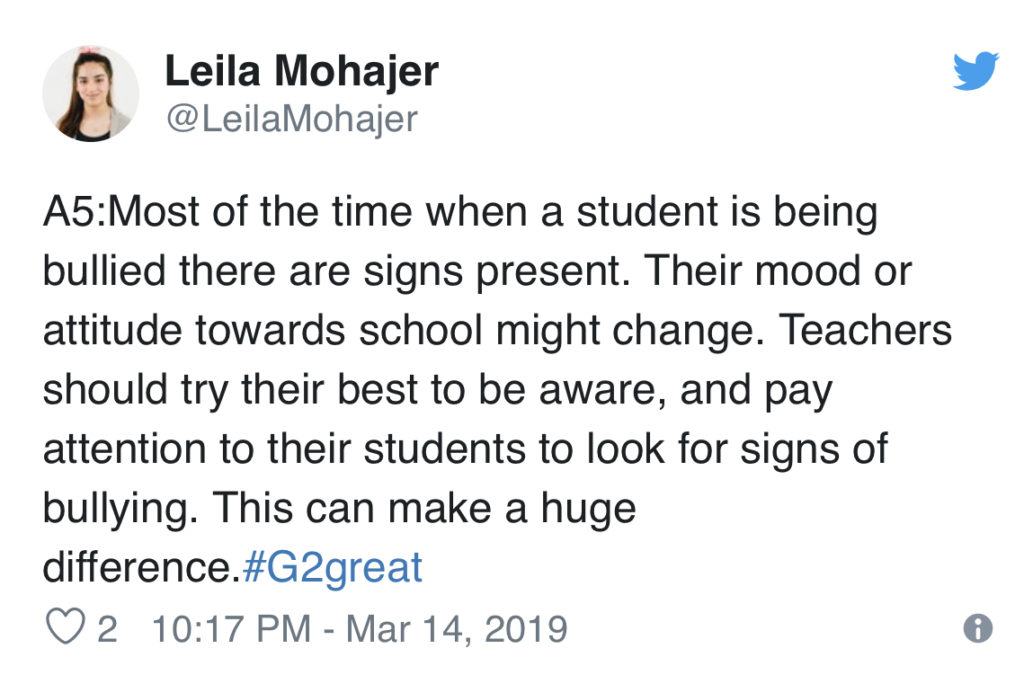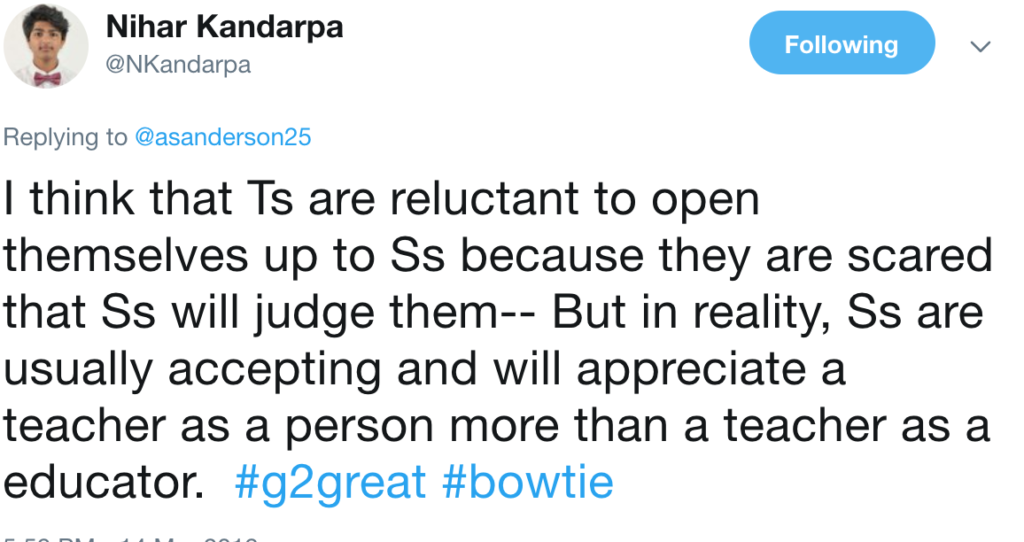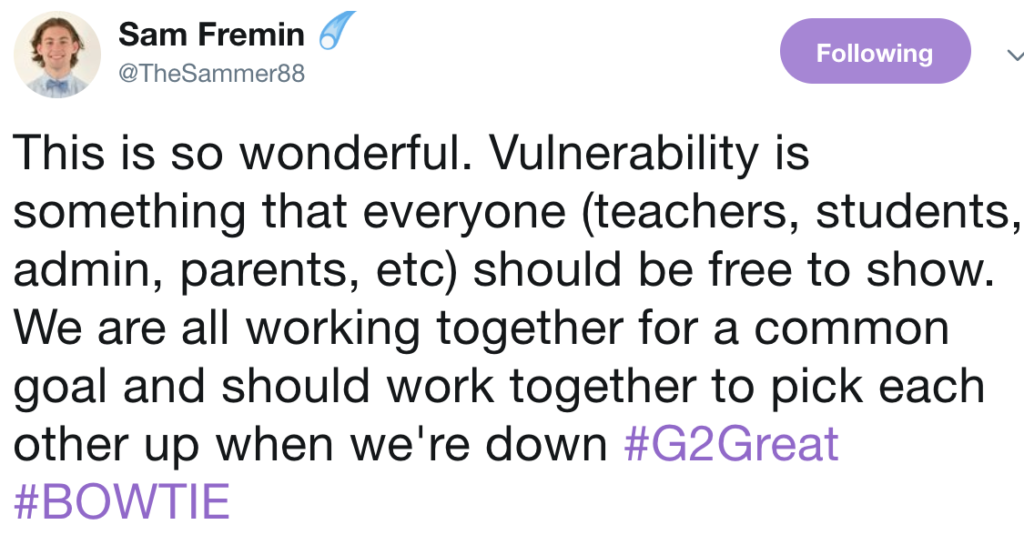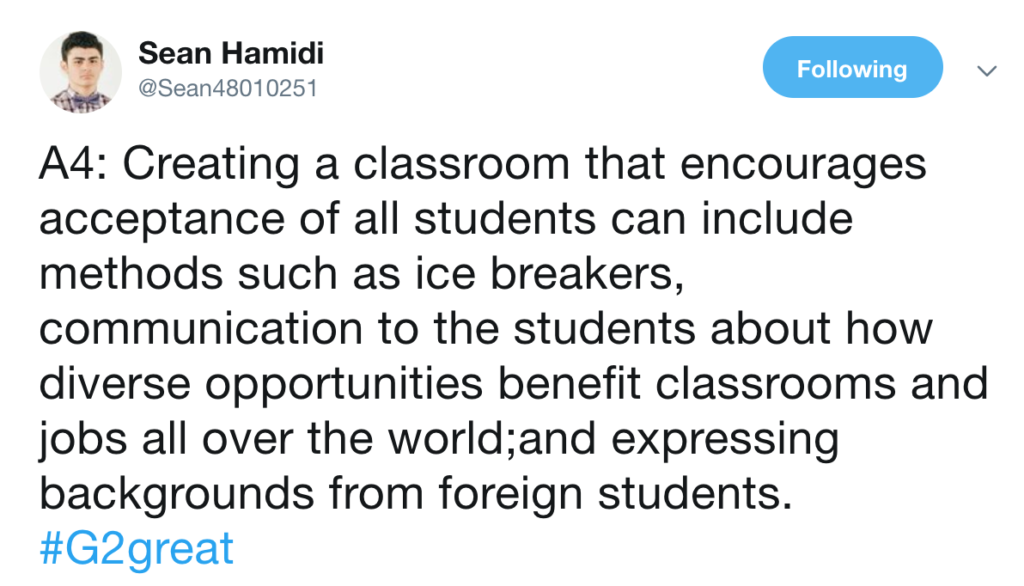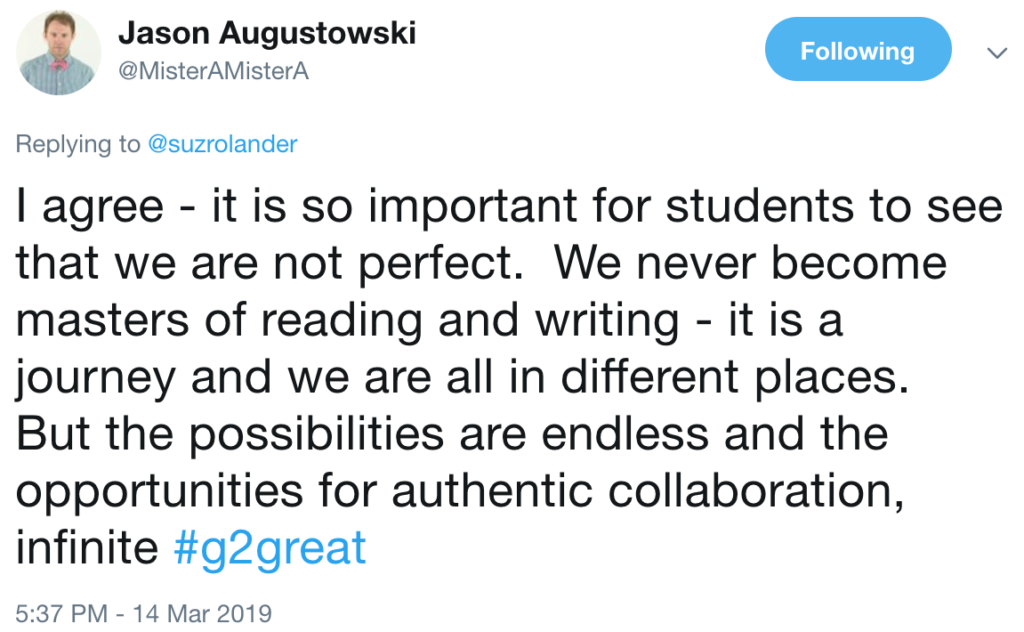Guest bloggers Kitty Donohoe, Brent Gilson, and Jill Davidson with Mary Howard
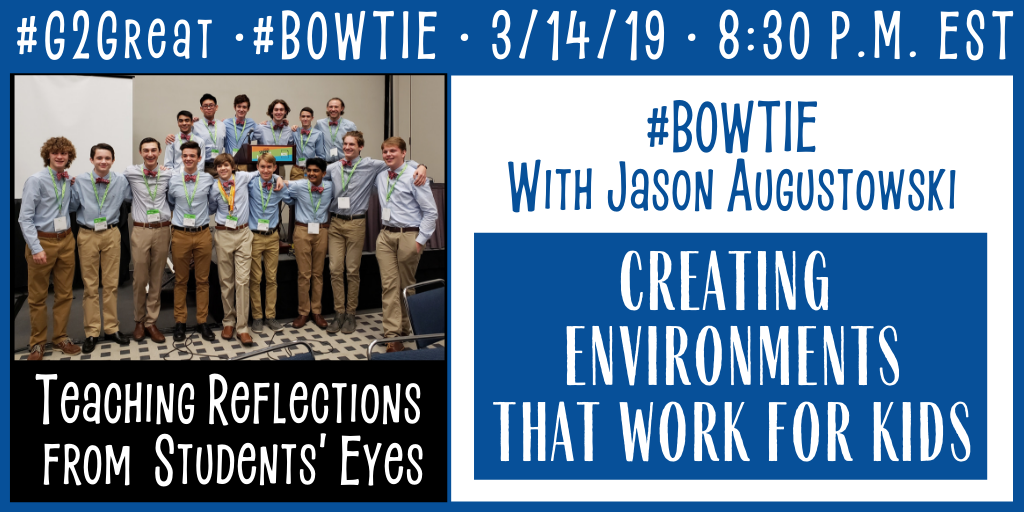
#G2Great was once again abuzz with excitement when our good friends and newly reorganized #BOWTIE students took the seat of honor at the #G2Great guest host table for the eighth time: 12/13/18, 4/26/18, 3/8/18, 5/25/17, 3/6/17, 12/17/17, 6/9/16 (Sam Fremin). They have been our guest hosts more than any other guest in our four year chat history, which tells you how much we think of them. On 3/14/19, we gathered together to explore Creating Environments that Work for Kids
#BOWTIE are middle school and high school students who write and talk about education under the support of teacher, Jason Augustowski. They share their ideas about education at national conferences like NCTE, write blog posts and read professional texts to extend their understandings. It’s fitting that #BOWTIE is an acronym for Bringing Our “Why” (because) Teachers Include Everyone since they have become professional co-conspirators who offer reflective insight about the teaching/learning process.
Educational commitment is apparent each time #BOWTIE joins #G2Great. They choose the topic, write questions and lead our dialogue. Eighteen students joined us this week: Erik Bright (grade 9); Gabriella David (grade 9); Aaron Eichenlaub (grade 8); Ben Fremin (grade 8); Sam Fremin (grade 12); Sean Hamidi (grade 10); Nihar Kandarpa (grade 9); Chrysa (grade 9) Sarah Lehner (grade 8); Jack Martinez (grade 9); Leila Mohajer (grade 9); Jason Nguyen (grade 9); Joseph O’Such (grade 11); Sabrina Rice (grade 8); Elizabeth Salmon (grade 8); Christian Sporre (grade 11); Giana Woodson (grade 8); Anya Passino (grade 9). I love this picture taken just before the chat started:
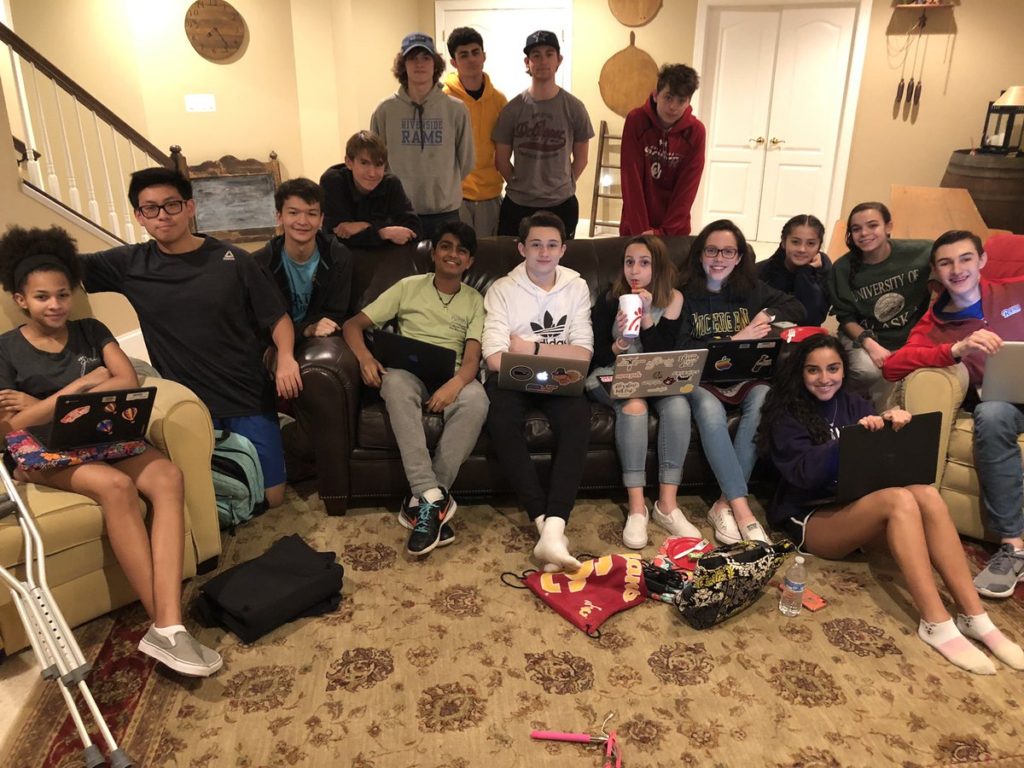
For our eighth #BOWTIE – #G2Great thought merger, we invited friends who think as highly of these young men and women and we do. We are so grateful to Kitty Donohoe, Brent Gilson and Jill Davidson for sharing their thoughts around five questions:
What could educators do to create an environment that truly works for kids?
Kitty Donohoe
After engaging in conversation with the inspiring #BOWTIE students, I recollected a favorite quote of Oscar Wilde: “Be yourself; everyone else is already taken.” It is easy to conjure an image of the proverbial old-fashioned teacher who doesn’t smile until winter break. However, as in all things, there needs to be a balance in life. The students talked about how much they loved hearing stories from their teachers about what life was like for them at the same age. Humor and a sense of mutual respect that needed to be earned was important to the students. On that first day of school, dynamic relationship building has more merit than a static syllabus. After all, what transcends is the relationships built, not a set of rules and a grim-faced teacher.
Brent Gilson
This past week we discussed creating environments that work for kids and I am grateful to have the chance to reflect back on the chat and my own thoughts on what we as educators can do to create the best environment for our students. When we are looking at classroom culture and creating a space that works for our students to feel safe to learn and collaborate I can’t help but think the first steps should always be hearing from our students. Being vulnerable enough as an instructor to admit that we don’t have all the answers allows our students to feel like partners in creating the best classroom environment. Collaboration with peers and with students and teachers will increase if we show this vulnerability (Suzy Rolander) It reminds me of how Pernille Ripp asks her students to tell her about what makes reading fun and what makes it suck. Their thoughts inform her practice and her example has helped me to take the same leap. What we learn from our students is priceless. I recently blogged about giving my students a chance to reflect on reading practices and it was eye-opening and helpful to me in creating an environment that is working for my students.
Jill Davidson
For me, the key word here is “create.” Creating an atmosphere that supports and engages all the learners in a classroom requires intention and reflection. We cannot develop an environment that works for all learners without inviting students’ voices into the conversation. Ask students for input on designing both the space and the learning that will take place within it. Regular debriefs on what is working and what needs to change give students an opportunity to identify their learning needs and articulate how the environment can help meet those needs. The learning environment encompasses much more than the physical space. Educators can actively participate in creating and sustaining a supportive atmosphere for learning by modeling the kind of learning that will happen in the classroom: sharing their own learning, taking risks as a learner, and being open about their curiosities and interests. One key theme that emerged from the chat was how much students appreciate a teacher who interacts with them as a collaborator and fellow learner.
What are some “environment take-aways” you learned from our #BOWTIE chat?
Kitty Donohoe
The relationship building environment is the heart of what matters. Thus, a teacher conveying the verbal and nonverbal messages to students of being present to them and that they matter, should be foremost in a classroom. The physical environment also has importance. Are desks clustered to foster collaborative learning? Is the classroom one that invites student choice in projects? Are partnerships encouraged so that students can learn from each other, thus making the whole greater than the sum of its parts? Is inclusivity modeled by all? Can students see their faces reflected in classroom libraries? All of these and many more components matter.
Brent Gilson
As we discussed the classroom environment the idea of balancing the fun-loving freedom with purposeful workspace came up often. I hope in my classroom that a foundation of mutual respect will take us much further than any “rules” will. A common thread among posts came up in that students need clear expectations and the sense that there will be follow through. Students need communication and clarity in what the expectations are. Reducing expectations only to then have to come down harder later is only going to serve to disrupt the space and the relationships that we have with our students. After the chat this week I really sat and thought about where my line is and how much I erase it in an effort to give infinite chances. It led to some tough conversations and hopefully, the concerns I had Thursday evening will be a thing of less frequency going forward.
Jill Davidson
Throughout the chat the importance of safe, equitable, and inclusive spaces came out loud and clear. Students value classrooms and schools where they feel they have a say in their own learning and where all voices and perspectives are valued equally. They want to learn in environments that make them feel seen and heard. The importance of using reading, writing, speaking, and listening to learn about others and ourselves surfaced over and over during the conversation. Another key take-away for me was the reminder of how educators set the tone for the environment. Students appreciate having teachers who take the time to get to know them and who make relationship-building a priority.
How do educators benefit by viewing our teaching from a student lens?
Kitty Donohoe
I remember that when I was a first year teacher, a parent asked me where I bought my shoes because her daughter wanted a pair just like them! I was so surprised. But then I thought, of course, it is all about viewpoint. My primary aged students sat on the rug in front of me and my shoes are front and center. If my shoes were front and center, well then certainly there were even more important things that I needed to think about from their perspective. Teachers need to always remember what it is like to be a student. We have more power over a young person’s life than we sometimes realize. It is a sacred trust. Educators always need to understand that for a certain part of their life, these young people are a primary responsibility for us. This can never be taken for granted. And, it is easy to overlook their perspective. By hearing from the Bowtie students, it was a lovely reminder about how by building trust, teachers can give students more agency in the classroom. The more responsibility students have, the more their confidence can grow, and the more engaged they will become in the learning community.
Brent Gilson
When we take the time to look at things from a student lens I think we can really, if we are truly open to it, change the way we teach. So often in University, we were told to have all these intricate plans to make sure we keep our students captivated but too often they are just captive. When we look at the tasks we assign, or even do them we see if the activity is worthy of our students. We start to see the points that might get them caught up and can be proactive versus reactive.
Jill Davidson
Viewing teaching (and learning) from a student lens helps us be responsive and empathetic educators. We often talk about “authentic learning,” and to be truly authentic classroom activities must reflect the lives of the learners. Do the texts students are reading and creating reflect their world outside of the classroom? Are students writing about topics that are meaningful to them for an audience beyond the teacher? Is the use of technology purposeful in that it extends and expands learning rather than being an add-on? Considering the learning environment from the student perspective encourages us to find opportunities to increase engagement and agency. We can look for the places where we are making decisions for students’ learning that they can be making for themselves. We can reflect on where student voice and choice can be amplified. It is essential that students have a say in what they will learn and how they will learn it.
What is one way #BOWTIE has inspired your professional understandings?
Kitty Donohoe
It is always important to reflect on one’s practice as an educator. And what better way to do this than by hearing from young people? The BOWTIE students are remarkable. During the chat and afterwards, as I was thinking about their insights, I was struck by how much wisdom these young students have. They made me think about how important dialogue is with students. By listening with an open heart, a teacher truly can have more impact. Student voices are important to reflect back to teachers what works from a younger perspective. So in essence, it made me think about always going back to the source. In my case, I am working with second graders. Their thoughts matter. They are more aware of what it is to be seven or eight than I am, thus, go to the experts for insights!
Brent Gilson
I have had the pleasure of joining in on a number of chats that the formerly #bowtieboys now rebranded as #BOWTIE have hosted on Twitter and attended a few of their sessions at NCTE this year and am always impressed by their passion and dedication to taking steps forward in education. This #bowtie chat really helped me to see that I am not really doing my students favours by constantly moving the goal line closer. I have read articles about lawnmower or snowplow parents that just get everything out of their students way and through this chat I see that I at times do that for my students when they reach a tough spot. Seeing these students discuss topics that are important to them in such an open and educated way makes me see that my students don’t need me to guide them as much. That we need to look at learning as even more of a partnership where I provide them with support and guidance but also step back to let them problem solve more.
Jill Davidson
The themes of relationship-building, collaboration, and community that surfaced from this discussion have reinforced my passion for using talk as a way to grow learning. The majority of talk happening in the classroom should be from the students. They want to discuss important topics, share ideas, develop new understandings, and consider alternate perspectives. Again, establishing an environment where student talk is at the forefront takes careful planning. Everything from the physical set-up to the curricular materials must be selected with student talk in mind. Students need time and space to gather and discuss, but they also need engaging texts that give them something to talk about!
What advice/feedback do you have for #BOWTIE as a result of our chat, perusing their blogs or personally seeing them present at a conference?
Kitty Donohoe
To quote Bob Dylan: “May you stay forever young.” Your wisdom, courage, and dedication shine through in your Twitter conversations. You are our future and because I know that, I am at peace. Stay close to that vibrancy and tenacity that you exhibit your whole life for really, that is what life is all about. Thank you for letting me learn so very much from you.
Brent Gilson
Having participated and witnessed live the magic that is #bowtie first I would like to say that I think all teachers need the experience. They opened my eyes to the potential my students have to use their own voices and advocate for themselves. The passion in promoting voice/choice and helping educators take into account a different perspective is admirable. We often talk about stakeholders in education and I believe that to truly have a conversation that places all stakeholders as equal partners we need to fully listen and the #BOWTIE kids are speaking loud and clear, and teachers should be grateful.
Jill Davidson
Don’t stop putting your voices into the world. We have so much to learn from our students! Thank you for posing questions that invite us to reflect and for sharing your insights and experiences.
Mary’s Closing Thoughts
Since our first #G2Great chat January 8, 2015, co-moderators Fran, Val, Jenn, Amy (and Mary) have been committed to creating a space for learning in the company of others. Our goal from the beginning was to nurture an invitational culture of joyful dialogue where we could grow side-by-side twitter style. It’s apparent when looking back on the chat dialogue that these amazing students epitomize that vision. They understand that our day-to-day professional choices matter and that the quality of our choices rises from deep professional reflection that often leads to intentional shifts in thinking with students in mind.
One of the things that inspires me about our #BOWTIE friends is how generously they are willing to make their thinking public so that we can see our teaching through their wise eyes. Using their words, they hold up a reflective mirror for each of us so that we may design (and re-design) the best possible experiences for our students possible so that we can see our teaching in a new light.
We are so grateful to #BOWTIE students and teacher, Jason Augustowski for helping us to be the best version of ourselves. (Note: Please join us on 4/25/19 when they return to #G2Great)
Tweets from our incredible #BOWTIE contributors
